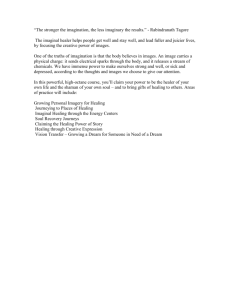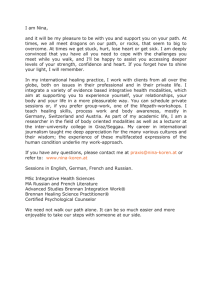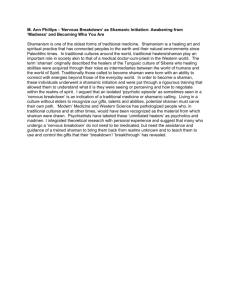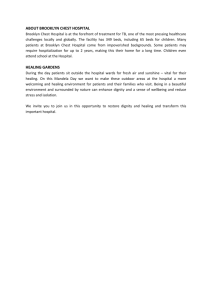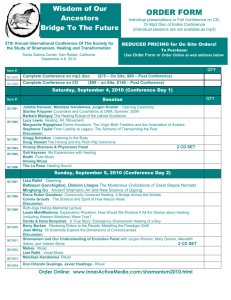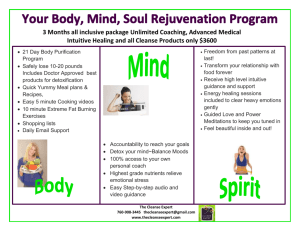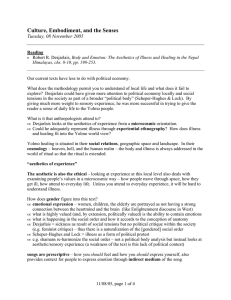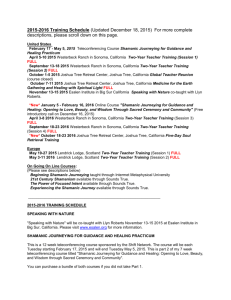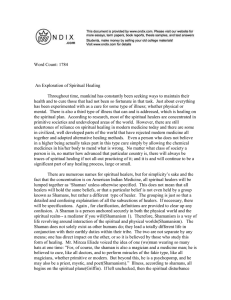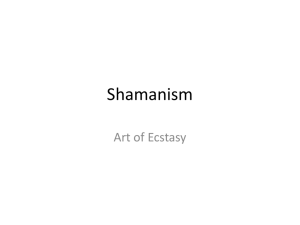the first mind-body medicine: bringing shamanism
advertisement
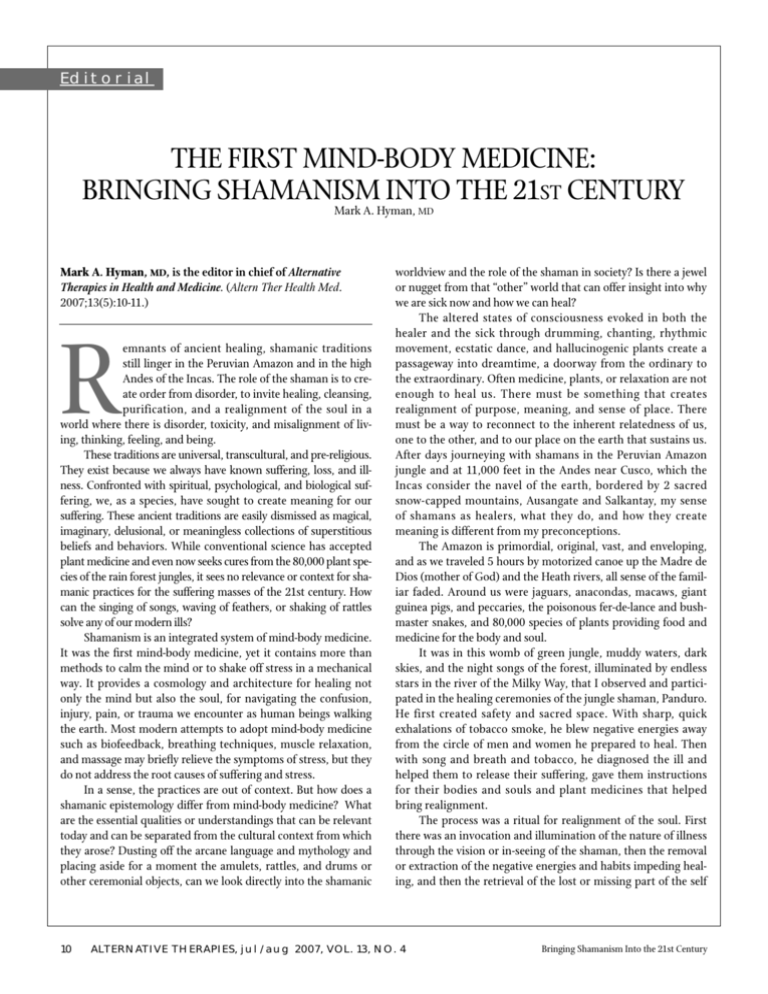
Editorial THE FIRST MIND-BODY MEDICINE: BRINGING SHAMANISM INTO THE 21ST CENTURY Mark A. Hyman, MD Mark A. Hyman, MD, is the editor in chief of Alternative Therapies in Health and Medicine. (Altern Ther Health Med. 2007;13(5):10-11.) emnants of ancient healing, shamanic traditions still linger in the Peruvian Amazon and in the high Andes of the Incas. The role of the shaman is to create order from disorder, to invite healing, cleansing, purification, and a realignment of the soul in a world where there is disorder, toxicity, and misalignment of living, thinking, feeling, and being. These traditions are universal, transcultural, and pre-religious. They exist because we always have known suffering, loss, and illness. Confronted with spiritual, psychological, and biological suffering, we, as a species, have sought to create meaning for our suffering. These ancient traditions are easily dismissed as magical, imaginary, delusional, or meaningless collections of superstitious beliefs and behaviors. While conventional science has accepted plant medicine and even now seeks cures from the 80,000 plant species of the rain forest jungles, it sees no relevance or context for shamanic practices for the suffering masses of the 21st century. How can the singing of songs, waving of feathers, or shaking of rattles solve any of our modern ills? Shamanism is an integrated system of mind-body medicine. It was the first mind-body medicine, yet it contains more than methods to calm the mind or to shake off stress in a mechanical way. It provides a cosmology and architecture for healing not only the mind but also the soul, for navigating the confusion, injury, pain, or trauma we encounter as human beings walking the earth. Most modern attempts to adopt mind-body medicine such as biofeedback, breathing techniques, muscle relaxation, and massage may briefly relieve the symptoms of stress, but they do not address the root causes of suffering and stress. In a sense, the practices are out of context. But how does a shamanic epistemology differ from mind-body medicine? What are the essential qualities or understandings that can be relevant today and can be separated from the cultural context from which they arose? Dusting off the arcane language and mythology and placing aside for a moment the amulets, rattles, and drums or other ceremonial objects, can we look directly into the shamanic R 10 worldview and the role of the shaman in society? Is there a jewel or nugget from that “other” world that can offer insight into why we are sick now and how we can heal? The altered states of consciousness evoked in both the healer and the sick through drumming, chanting, rhythmic movement, ecstatic dance, and hallucinogenic plants create a passageway into dreamtime, a doorway from the ordinary to the extraordinary. Often medicine, plants, or relaxation are not enough to heal us. There must be something that creates realignment of purpose, meaning, and sense of place. There must be a way to reconnect to the inherent relatedness of us, one to the other, and to our place on the earth that sustains us. After days journeying with shamans in the Peruvian Amazon jungle and at 11,000 feet in the Andes near Cusco, which the Incas consider the navel of the earth, bordered by 2 sacred snow-capped mountains, Ausangate and Salkantay, my sense of shamans as healers, what they do, and how they create meaning is different from my preconceptions. The Amazon is primordial, original, vast, and enveloping, and as we traveled 5 hours by motorized canoe up the Madre de Dios (mother of God) and the Heath rivers, all sense of the familiar faded. Around us were jaguars, anacondas, macaws, giant guinea pigs, and peccaries, the poisonous fer-de-lance and bushmaster snakes, and 80,000 species of plants providing food and medicine for the body and soul. It was in this womb of green jungle, muddy waters, dark skies, and the night songs of the forest, illuminated by endless stars in the river of the Milky Way, that I observed and participated in the healing ceremonies of the jungle shaman, Panduro. He first created safety and sacred space. With sharp, quick exhalations of tobacco smoke, he blew negative energies away from the circle of men and women he prepared to heal. Then with song and breath and tobacco, he diagnosed the ill and helped them to release their suffering, gave them instructions for their bodies and souls and plant medicines that helped bring realignment. The process was a ritual for realignment of the soul. First there was an invocation and illumination of the nature of illness through the vision or in-seeing of the shaman, then the removal or extraction of the negative energies and habits impeding healing, and then the retrieval of the lost or missing part of the self ALTERNATIVE THERAPIES, jul/aug 2007, VOL. 13, NO. 4 Bringing Shamanism Into the 21st Century or soul, finally reconnecting to meaning, vision, and purpose.1 The role of community in the healing process created a container for the sick to be cleansed, free, and able to see and know meaning and purpose in the family of human beings. The process created balance and realignment. It addressed body and soul sickness at the root. More than stress alone contributes to or creates the majority of modern chronic diseases, from the epidemic of mental disorders including depression and anxiety to heart disease and more. Dis-ease is a disconnection from our sense of place in the world, from a loss of control and meaning as we drift on the television, channel to channel, looking for a program to satisfy us and consume food that is disconnected from its origins, processed and unidentifiable from its natural state, as our families separate, disconnect, and communicate through text messaging and e-mail. It is not poverty that increases the prevalence of illness, morbidity, and mortality but a loss of sense of culture, control, and meaning.2 The shamans provide a doorway back to meaning, to a sense of place and control and order in our world. The mind-body understanding in health and disease needs to include not only tools for relaxation but also tools and rituals and context for realignment of the soul. Modern biologic discoveries mirror shamanic work. The deep understanding of systems biology and the origins of disorder and biologic dysfunction and the re-establishment of balance and harmony provide a new scientific framework for healing. Traditional shamanic practices and cosmologies use a consistent model of healing. First the shaman identifies and removes negative energies in each of the body’s energy channels, identifies imbalances and removes the causes on a physical and soul level, and then restores balance and harmony in the body’s core energy systems and re-establishes connection and harmony in relationship. Systems biology and medicine (for which functional medicine provides a robust clinical model) operate from a similar framework.3 In order to create healing, the core systems of the body (meaning the body-mind and the mind-body) and the interrelationships or patterns that connect all these systems must be understood as a whole. Healing cannot occur out of context. Healing is created through an understanding of imbalance in each of the core systems and how these patterns of imbalance interconnect and influence each other. Once the imbalances are identified, factors that have created them (negative energies), such as poor diet, stress, social disconnection, toxins, infections, and allergens, must be removed (extracted). Then the ingredients for restoration and balance, such as quality food, adequate nutrients for restoration of optimal function, rest, sleep, exercise, rhythm, light, air, water, connection, love, and community, must be provided. Once the systems of the body are realigned, harmonized, and balanced, healing is possible. The ancient cosmologies and modern molecular biology take us to the same places and provide complementary tools to achieve a healing of the body, mind, and soul, all of which are Bringing Shamanism Into the 21st Century necessary for health and to establish our place in the world. The challenge of mind-body medicine is to embrace, contain, and include the human need for purpose, connection, and meaning. —Mark Hyman, MD REFERENCES 1. Villoldo A. Shaman, Healer, Sage: How to Heal Yourself and Others with the Energy Medicine of the Americas. New York: Harmony Books; 2000. 2. Lantz PM, House JS, Lepkowski JM, Williams DR, Mero RP, Chen J. Socioeconomic factors, health behaviors, and mortality: results from a nationally representative prospective study of US adults. JAMA. 1998;279(21):1703-1708. 3. The Textbook of Functional Medicine. Gig Harbor, WA: Institute for Functional Medicine; 2005. ALTERNATIVE THERAPIES, jul/aug 2007, VOL. 13, NO. 4 11
